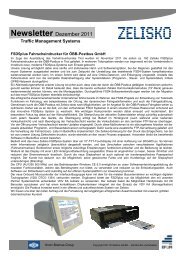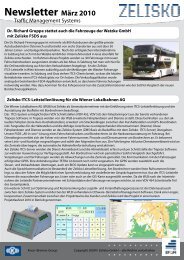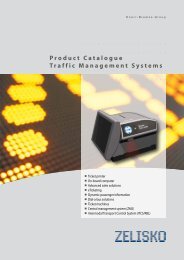Annual Report 2012 - Knorr-Bremse AG.
Annual Report 2012 - Knorr-Bremse AG.
Annual Report 2012 - Knorr-Bremse AG.
You also want an ePaper? Increase the reach of your titles
YUMPU automatically turns print PDFs into web optimized ePapers that Google loves.
<strong>Report</strong><br />
69<br />
Differential lock for commercial vehicles assists truck drivers<br />
Drivers sometimes find it difficult to decide when to activate the differential lock and when it is<br />
better not to. The result is that it is often switched on too late, when the vehicle has already stopped<br />
moving or one wheel is already spinning so much that the differential lock no longer engages. The<br />
so-called Differential Lock Control system developed by <strong>Knorr</strong>-<strong>Bremse</strong> helps the driver by activating<br />
the lock on solo and tandem rear axles and automatically deactivating it again as soon as it is no<br />
longer required.<br />
If one or more wheels start to spin, the system applies the brake to the spinning wheel(s) to synchronize<br />
the axle concerned, and then automatically activates the differential lock. To speed up<br />
the process, ensure rapid activation and minimize wear, the drive train may also be briefly disengaged.<br />
New ST7-430 trailer brake boosts efficiency in trailers too<br />
The new ST7-430 brake literally lightens the load for trailers. This successor to the successful SK7 is<br />
one of the lightest two-piston disc brakes for 22.5-inch wheels on the market. The ST7-430 is designed<br />
for 9-tonne trailer axles and thanks to its optimized disc and caliper weighs in at around four<br />
and a half kilograms less than its predecessor. This means that for a classical trailer application the<br />
unladen weight is reduced by 27 kg. The fact that this enables the load volume to be increased is, if<br />
you take a mineral oil tanker as an example, a strong argument for purchasing the system. And if the<br />
full load capacity is not used, the 27 kg saved will certainly reduce fuel consumption. Thus either<br />
way, trailer efficiency can be increased. During <strong>2012</strong> prototype testing was completed and preparations<br />
made for customer field testing.<br />
Compressor development for hybrid applications<br />
There are still many unanswered questions about how truck hybrid applications can be used effectively<br />
in the medium and long term, but one thing is clear: sooner or later such modern drive systems<br />
are going to be found in this segment. It is also clear that the compressors used to generate air for the<br />
braking system will no longer be powered by the vehicle’s combustion engine, as – depending on<br />
the type of system involved – it temporarily switches off during hybrid operation. And, of course in<br />
the case of fully electric vehicles, the combustion engine will cease to exist completely. Hence the<br />
need to look to the future and develop an electrically-powered compressor.<br />
The new electrically-powered<br />
compressor<br />
is designed for<br />
maximum flexibility<br />
and can be installed<br />
in a wide range of<br />
hybrid vehicles.<br />
During the year under review, <strong>Knorr</strong>-<strong>Bremse</strong> started to work on a prototype electric compressor that<br />
is also oil-free and air-cooled, as current compressors are not just mechanically linked to the vehicle’s<br />
combustion engine but also share its oil- and water-cooling system. The new compressor is completely<br />
separate from the drive system and can be installed anywhere in the vehicle as a stand-alone,<br />
battery-powered component. <strong>Knorr</strong>-<strong>Bremse</strong> sees the main use of hybrid drive systems as being on<br />
urban buses and local distribution trucks, so the new battery has been designed to be highly flexible<br />
and capable of installation in a wide variety of different vehicle types. At the same time the emphasis<br />
during the development stage was on noise and vibration reduction.<br />
Volume production launched of new slack adjusters for disc brakes<br />
Slack adjusters are essential elements of any disc brake, as they ensure that the running clearance<br />
between the brake pads and disc remains constant, however much wear the pads are exposed to.<br />
During <strong>2012</strong> <strong>Knorr</strong>-<strong>Bremse</strong> successfully launched volume production of its new N2G slack adjuster.<br />
These will initially be installed on semi-trailer tractor units, and in 2013 will be rolled out for the entire<br />
range of disc brake applications including truck trailers.



![1 Newsletter 2013 Version 0 92 [Kompatibilitätsmodus] - Zelisko](https://img.yumpu.com/50939577/1/184x260/1-newsletter-2013-version-0-92-kompatibilitaatsmodus-zelisko.jpg?quality=85)




![Backofficelösung ZMS [PDF, 740 kB] - Zelisko](https://img.yumpu.com/33964695/1/184x260/backofficelaasung-zms-pdf-740-kb-zelisko.jpg?quality=85)

![Geschäftsbericht 2012 [PDF, 13 MB] - Zelisko](https://img.yumpu.com/31517535/1/184x260/geschaaftsbericht-2012-pdf-13-mb-zelisko.jpg?quality=85)


![Produktkatalog Gesamtlösungen [PDF, 4 MB] - Zelisko](https://img.yumpu.com/22973479/1/182x260/produktkatalog-gesamtlaasungen-pdf-4-mb-zelisko.jpg?quality=85)
![ITCS Datenblatt [PDF, 804 kB] - Zelisko](https://img.yumpu.com/22855155/1/184x260/itcs-datenblatt-pdf-804-kb-zelisko.jpg?quality=85)
![Fahrscheindrucker FSD5plus [PDF, 934 kB] - Zelisko](https://img.yumpu.com/22822643/1/184x260/fahrscheindrucker-fsd5plus-pdf-934-kb-zelisko.jpg?quality=85)
